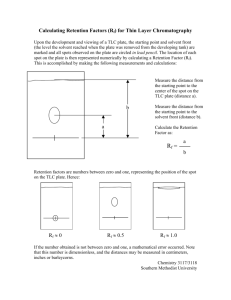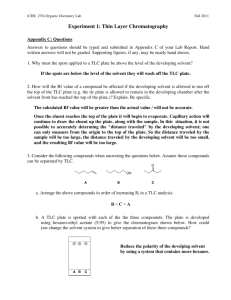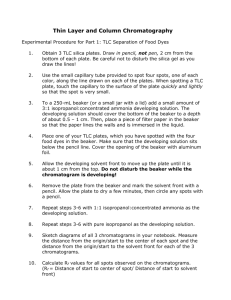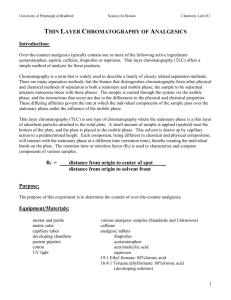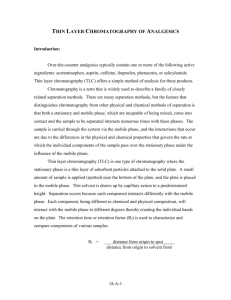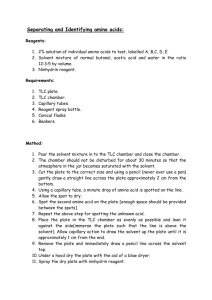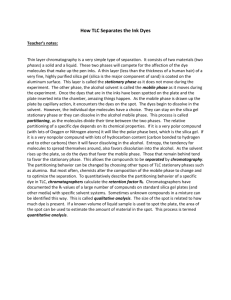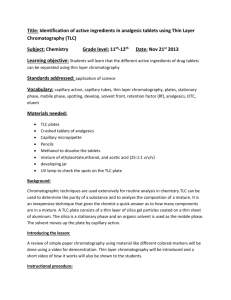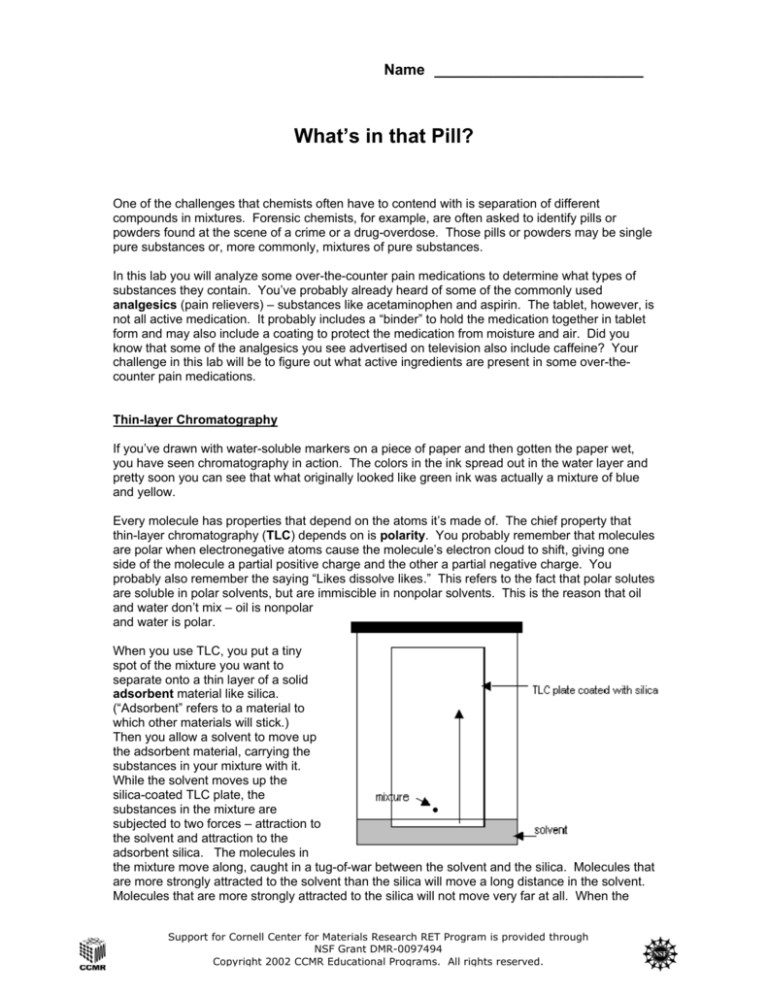
Name _________________________
What’s in that Pill?
One of the challenges that chemists often have to contend with is separation of different
compounds in mixtures. Forensic chemists, for example, are often asked to identify pills or
powders found at the scene of a crime or a drug-overdose. Those pills or powders may be single
pure substances or, more commonly, mixtures of pure substances.
In this lab you will analyze some over-the-counter pain medications to determine what types of
substances they contain. You’ve probably already heard of some of the commonly used
analgesics (pain relievers) – substances like acetaminophen and aspirin. The tablet, however, is
not all active medication. It probably includes a “binder” to hold the medication together in tablet
form and may also include a coating to protect the medication from moisture and air. Did you
know that some of the analgesics you see advertised on television also include caffeine? Your
challenge in this lab will be to figure out what active ingredients are present in some over-thecounter pain medications.
Thin-layer Chromatography
If you’ve drawn with water-soluble markers on a piece of paper and then gotten the paper wet,
you have seen chromatography in action. The colors in the ink spread out in the water layer and
pretty soon you can see that what originally looked like green ink was actually a mixture of blue
and yellow.
Every molecule has properties that depend on the atoms it’s made of. The chief property that
thin-layer chromatography (TLC) depends on is polarity. You probably remember that molecules
are polar when electronegative atoms cause the molecule’s electron cloud to shift, giving one
side of the molecule a partial positive charge and the other a partial negative charge. You
probably also remember the saying “Likes dissolve likes.” This refers to the fact that polar solutes
are soluble in polar solvents, but are immiscible in nonpolar solvents. This is the reason that oil
and water don’t mix – oil is nonpolar
and water is polar.
When you use TLC, you put a tiny
spot of the mixture you want to
separate onto a thin layer of a solid
adsorbent material like silica.
(“Adsorbent” refers to a material to
which other materials will stick.)
Then you allow a solvent to move up
the adsorbent material, carrying the
substances in your mixture with it.
While the solvent moves up the
silica-coated TLC plate, the
substances in the mixture are
subjected to two forces – attraction to
the solvent and attraction to the
adsorbent silica. The molecules in
the mixture move along, caught in a tug-of-war between the solvent and the silica. Molecules that
are more strongly attracted to the solvent than the silica will move a long distance in the solvent.
Molecules that are more strongly attracted to the silica will not move very far at all. When the
Support for Cornell Center for Materials Research RET Program is provided through
NSF Grant DMR-0097494
Copyright 2002 CCMR Educational Programs. All rights reserved.
solvent has moved up the plate, molecules of different substances will make different spots on
the plate.
When a particular solvent is used (hexane for
example) substances in the mixture will always
behave the same way. Their behavior is so
predictable that we can use this technique to help
identify the substances. If you separated samples
of the same mixture on different TLC plates using
hexane as the solvent each time, you would see
the same pattern of spots each time. The only
thing that might change the exact position of the
spots is the length of time you run the experiment.
To handle this variable, chemists express the
distance that a spot moves as a ratio – the ratio of
the distance the spot moves to the distance the
solvent moves. The ratio is referred to as the Rf
and the formula for calculating it is below:
Rf = distance moved by spot
distance moved by solvent
Since the solvent always moves at least as far as anything dissolved in it, the value of the Rf is
always less than 1.
TLC has been used by chemists for identification of unknown substances for quite a while, so
many substances have been tested and their Rf values are known. Using a different solvent will
change the Rf value, so when you report your Rf value, you should also indicate the solvent you
are using.
Visualizing the Results
Unfortunately, unless the substances you are separating are colored, you won’t be able to see
them when you look at your TLC plate. In the lab, chemists may expose the TLC plates to
chemicals like iodine that will react with the organic molecules they are trying to identify,
producing visible brown spots. You will be using a slightly different technique to visualize your
results.
The TLC plates that you are using are made of a plastic base, covered with a thin layer of silica.
Mixed into the silica layer is a fluorescent material. Fluorescent materials are substances that
absorb light in the UV range (invisible to our eyes) and give off light in the visible range. These
materials appear to glow when they are exposed to UV or “black light.”
What happens on the molecular level when fluorescence occurs? Imagine a relaxed molecule
(in the ground state) being struck by a photon of UV light. The molecule absorbs the photon and
one of its electrons immediately becomes excited. This disturbs the ground state molecule’s
electron cloud and the whole molecule “tenses up” and becomes excited too. Not being very
comfortable in this excited state, the molecule begins to vibrate and relax a little. It continues
vibrating and finally relaxes enough to be able to take one big fall back down to its ground state.
In this last fall, it releases the remaining energy in the form of a photon of light. Since some of the
energy of the absorbed photon was used up in vibrations, the final photon has less energy than
the one that was absorbed. UV light is composed of high energy photons that we are unable to
see. Visible light has lower energy, but the receptors in our eyes are able to detect it.
Support for Cornell Center for Materials Research RET Program is provided through
NSF Grant DMR-0097494
Copyright 2002 CCMR Educational Programs. All rights reserved.
excited states
UV photon
visible photon
ground state molecule
ground state molecule
Actually, this is only one of the possible outcomes when a molecule becomes excited. In some
cases, the excited molecule may bump into another molecule in its environment and transfer its
energy to the other molecule. If the other molecule doesn’t release the transferred energy in the
form of a photon (if, for example, it just releases the energy a little at a time by vibrating) then no
fluorescence will occur. Instead of glowing, the substance will behave as if it isn’t fluorescent at
all. This is referred to as quenching. If you want something to fluoresce, quenching is bad, but
in the case of fluorescent TLC plates, it’s good. When you put a spot of your mixture onto the
fluorescent plate, the substances in the mixture will quench the fluorescence. In other words, the
plate will fluoresce everywhere except where the spot is. By looking at the plate under a UV light,
you will be able to tell where the initial spot is and also where the separated spots are at the end
of the experiment. The spots will be dark areas where the fluorescent molecules in the plate are
quenched by the substance you’ve put on the plate.
Analgesics
You will be examining over-the-counter medications to see if they contain one or more of the
substances pictured below – aspirin, acetaminophen and caffeine.
acetaminophen
aspirin
caffeine
Notice that each of these compounds contains different atoms. Oxygen and nitrogen are
considerably more electronegative than carbon and hydrogen. Since the arrangement of atoms
Support for Cornell Center for Materials Research RET Program is provided through
NSF Grant DMR-0097494
Copyright 2002 CCMR Educational Programs. All rights reserved.
is different in each case, the distribution of electrons in these molecules will also differ and they
will have different molecular polarities. This also means that they will interact differently with the
solvent and the silica adsorbent layer, so they will move different distances on the TLC plate.
Materials
10 mL graduated cylinder or pipette
400 mL beaker with Al foil cover (developing chamber)
TLC plate
small screw cap test tubes
pestle
standard solutions (aspirin, acetaminophen and caffeine)
medication tablets (Anacin, Tylenol, No-Doz and Excedrin)
UV light
95% ethanol
ligroin (petroleum ether)
ethyl acetate
microcapillary tubes
ruler
pencil
paper towels
safety goggles
waste containers (one for ethyl acetate and one for ligroin-ethanol)
Safety
As always, safety goggles must be worn whenever you are working in the lab area, even when
you are cleaning up.
The solvents used in this experiments are safe to use in small amounts in a well-ventilated room.
They are quite flammable, so make sure there is nothing that will produce a flame or spark in the
work area. You can minimize the risk by keeping the solvent containers closed whenever
possible.
When you are ready to dispose of wastes, pay attention to the labels on the waste containers.
There are two of them, one for the solvent used to dissolve the medication sample and the other
for the solvent used to run the TLC experiment. The waste containers are located in the fume
hood.
Used microcapillary tubes should be placed in the broken glass container.
UV light can cause eye damage, so never look directly into the light. Use the light to
locate and mark your spots and then turn it off. Your safety goggles protect against UV as
well as chemicals, so wear them when you look at your TLC plates.
Procedure
1. Prepare the developing chamber
a. You will share this chamber with another lab group. Fill the bottom of the beaker with
enough ethyl acetate to fill it to a depth of approximately 0.5 cm. Put the foil cover on
snugly and set it aside until you are ready to use it.
Support for Cornell Center for Materials Research RET Program is provided through
NSF Grant DMR-0097494
Copyright 2002 CCMR Educational Programs. All rights reserved.
2. Prepare the TLC plate
a. Handle the plate by the edges, being
careful not to touch it with your fingers.
Oil from your skin will interfere with the
movement of solvent on the plate. Look
at the plate and decide which edge is
the straightest – use this edge as the
bottom of the plate.
b. Use a dull #2 pencil to lightly draw a line
1 cm from the bottom of the plate and
make the other marks shown in the
drawing. Do not press hard enough to
dig into the silica layer – it’s fragile.
c. Lay the plate on a clean dry paper towel
until you are ready for it.
Caf
Ac
Asp
3. Prepare the solutions
a. Label two small, clean, dry screw cap
Label your own meds
tubes with the names of the medications
you’ve been given. Water will affect
your experiment, as will contaminants, so make sure they are clean and dry.
b. Place the first of your medication samples between two layers of paper towel. Use the
pestle to crush it to a fine powder. You will only need about one-fourth of a tablet, so if
you have crushed a full tablet, share the powder with another group.
c. Place the powder in the appropriately labeled beaker and add about 1 mL of ethanol and 1
mL of ligroin to the beaker and swirl it gently for a couple of minutes. Some of the solid
may not dissolve. This is not a problem. Pour the solution into a clean, dry, labeled
screw cap tube, being careful not to transfer the solid material. You will share this tube
with others.
d. Repeat steps b and c with your second medication sample.
4. Spot the practice plate
a. Your teacher will provide a small practice plate. Obtain a microcapillary tube and dip it into
one of the clear solutions you have just prepared.
b. Briefly touch the tip of the microcapillary tube to the pencil mark on the TLC plate. A small
amount of the liquid in the tube will be drawn onto the plate, making a small spot. The
solvent will evaporate in a few seconds. To apply another layer of your solution, touch
the end of the tube to the same spot and let it dry again. Keeping the spot small is very
important. You can apply several layers in the same spot, but make sure the solvent
dries between applications or your spot will begin to spread out. They should be about
this size •. Save the tube to use when you spot your experimental plate.
c. Look at your spot under UV light and have your teacher approve it.
5. Spot the TLC plate
a. Obtain standard solutions of aspirin, acetaminophen and caffeine. Carefully spot your TLC
plate directly on the pencil marks in the same way you spotted the practice plate. Use a
different microcapillary tube for each solution you spot.
b. Spot the solutions you prepared.
c. Ask your teacher to check the spots before you move on to the next step.
Support for Cornell Center for Materials Research RET Program is provided through
NSF Grant DMR-0097494
Copyright 2002 CCMR Educational Programs. All rights reserved.
6. Develop the TLC plate
a. Don’t go any further until the lab group you are sharing the developing chamber with is
ready.
b. Place the developing chamber on your lab table in a spot where it will remain undisturbed
for 15-20 minutes. Carefully remove the lid without sloshing the ethyl acetate.
c. Handle the plates by their top edges. Lower one plate into the jar so the markings are just
above the solvent level and let it lean against the side of the beaker. Lower the second
plate and put it into position opposite the first. Don’t let the plates touch.
d. Put the foil cover back on the jar without disturbing the solvent or the plates and do not
move the jar until development is over.
7. Dry the TLC plate
a. When the solvent has moved to within 1 cm of the top of the plate, remove both plates and
place them on a double layer of paper towel.
b. Immediately mark the solvent front with a pencil. The solvent front is the highest level
reached by the solvent. It will evaporate quickly so make sure you do this as soon as you
take the plate out of the chamber.
b. Replace the cap and ask your teacher if you should dispose of the solvent in the waste
container or leave it for another class to use.
8. Visualize the results
a. Wit your safety goggles on, look at your plate under the UV light. Outline all spots with a
pencil. If you have any questions about interpreting your results, ask your teacher for
help.
9. Calculate Rf values
a. Using a pencil, place a dot in the center of each of
the spots you’ve outlined.
b. Measure the distance in centimeters from the
staring line at the bottom of the plate to the
solvent front line. Record the measurement in
Data Table 1.
c. Measure the distance from the starting line to the
center of each spot of standard solution.
Record the measurement in Data Table 1.
d. Make the same measurements for the over-thecounter medications. Use the portions of the
Data Table 2 that are appropriate for the meds
you tested. If the meds produced more than
one spot, record measurements for each spot.
You can probably make tentative identifications
of the spots by comparing them with the
standards.
d. Calculate the Rf value for each spot using the
formula given in the introduction to the lab.
Record your results in the space provided in
each data table.
Exc
Caf
Ac
Asp
Support for Cornell Center for Materials Research RET Program is provided through
NSF Grant DMR-0097494
Copyright 2002 CCMR Educational Programs. All rights reserved.
Data and Calculations
First, record measurements and show your calculations for the standard solutions in the space
below.
Table 1
Standard
Solutions
Solvent Front
(cm)
Spot Distance
(cm)
Rf Value
Aspirin
Acetaminophen
Caffeine
In the space below, show your calculations for the standard solutions.
Aspirin Rf calculation:
Acetaminophen Rf calculation:
Caffeine Rf calculation:
Support for Cornell Center for Materials Research RET Program is provided through
NSF Grant DMR-0097494
Copyright 2002 CCMR Educational Programs. All rights reserved.
For the over–the-counter medications, record your results in the space below. You may need to use more than one space for a medication. For
example, if a medication shows more than one spot with TLC, you should record measurements and do calculations for each spot.
Table 2
Spot #1
Over-theCounter Meds
Spot
Distance
(cm)
Spot #2
Rf
Spot
Distance
(cm)
No Doz
Anacin
Excedrin
Tylenol
Support for Cornell Center for Materials Research RET Program is provided through
NSF Grant DMR-0097494
Copyright 2002 CCMR Educational Programs. All rights reserved.
Spot #3
Rf
Spot
Distance
(cm)
Rf
Drawing Conclusions:
Compare the Rf values from the standards in Table 1 with the Rf values from the medications in
Table 2. Identify the substance(s) present in each of the medications that you and your
colleagues tested:
Name of Medication: _____________________
Substance(s) Present:_________________________________________________________
Name of Medication: _____________________
Substance(s) Present:_________________________________________________________
Name of Medication: _____________________
Substance(s) Present:_________________________________________________________
Name of Medication: _____________________
Substance(s) Present:_________________________________________________________
1. What factors affect the distance that each spot travels on the plate?
2. What was the purpose of applying spots of known caffeine, aspirin and acetaminophen
solutions?
3. Ethyl acetate has the structure shown at the right.
In comparison with other solvents used for TLC, ethyl acetate is
relatively polar.
Based on this information, rank aspirin, acetaminophen, and caffeine in order of increasing
polarity:
________________________________________________________________
Support for Cornell Center for Materials Research RET Program is provided through
NSF Grant DMR-0097494
Copyright 2002 CCMR Educational Programs. All rights reserved.
4. Your eyes are not able to detect UV light. Explain what is happening when you look at a TLC
plate that appears to be glowing green.
5. Explain what is happening when you look at one of the spots on a TLC plate and it appears
dark.
6. Is it safe to assume that a mixture that produces two spots in your TLC experiment contains
only two substances? Why or why not?
7. Knowing when a chemical reaction is complete can be difficult. In an organic chemistry lab,
scientists who want to combine two different compounds in a synthesis reaction may take
samples of the reaction mixture periodically and run the samples on TLC plates until they see one
spot on the plate instead of two. Why does this tell them that the reaction is complete?
8. If you were to run this experiment a second time using the same chromatography solvent (ethyl
acetate), you would expect to get the same Rf values that you got the first time. If, however, you
used ethanol as a solvent, your Rf values would be different. Explain why this is true.
Support for Cornell Center for Materials Research RET Program is provided through
NSF Grant DMR-0097494
Copyright 2002 CCMR Educational Programs. All rights reserved.

